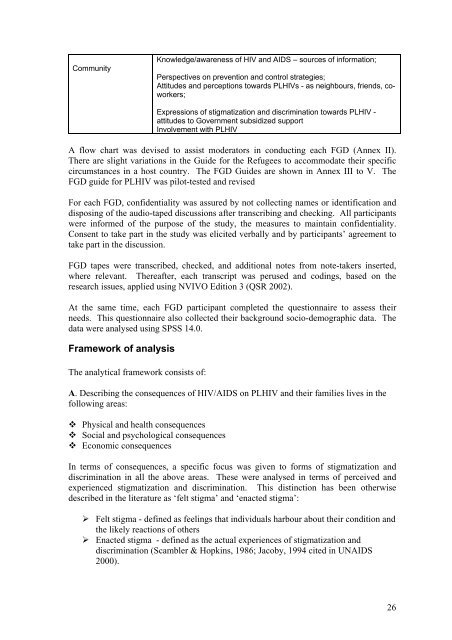Download this publication - AIDS Data Hub
Download this publication - AIDS Data Hub
Download this publication - AIDS Data Hub
Create successful ePaper yourself
Turn your PDF publications into a flip-book with our unique Google optimized e-Paper software.
CommunityKnowledge/awareness of HIV and <strong>AIDS</strong> – sources of information;Perspectives on prevention and control strategies;Attitudes and perceptions towards PLHIVs - as neighbours, friends, coworkers;Expressions of stigmatization and discrimination towards PLHIV -attitudes to Government subsidized supportInvolvement with PLHIVA flow chart was devised to assist moderators in conducting each FGD (Annex II).There are slight variations in the Guide for the Refugees to accommodate their specificcircumstances in a host country. The FGD Guides are shown in Annex III to V. TheFGD guide for PLHIV was pilot-tested and revisedFor each FGD, confidentiality was assured by not collecting names or identification anddisposing of the audio-taped discussions after transcribing and checking. All participantswere informed of the purpose of the study, the measures to maintain confidentiality.Consent to take part in the study was elicited verbally and by participants’ agreement totake part in the discussion.FGD tapes were transcribed, checked, and additional notes from note-takers inserted,where relevant. Thereafter, each transcript was perused and codings, based on theresearch issues, applied using NVIVO Edition 3 (QSR 2002).At the same time, each FGD participant completed the questionnaire to assess theirneeds. This questionnaire also collected their background socio-demographic data. Thedata were analysed using SPSS 14.0.Framework of analysisThe analytical framework consists of:A. Describing the consequences of HIV/<strong>AIDS</strong> on PLHIV and their families lives in thefollowing areas: Physical and health consequences Social and psychological consequences Economic consequencesIn terms of consequences, a specific focus was given to forms of stigmatization anddiscrimination in all the above areas. These were analysed in terms of perceived andexperienced stigmatization and discrimination. This distinction has been otherwisedescribed in the literature as ‘felt stigma’ and ‘enacted stigma’:‣ Felt stigma - defined as feelings that individuals harbour about their condition andthe likely reactions of others‣ Enacted stigma - defined as the actual experiences of stigmatization anddiscrimination (Scambler & Hopkins, 1986; Jacoby, 1994 cited in UN<strong>AIDS</strong>2000).26















